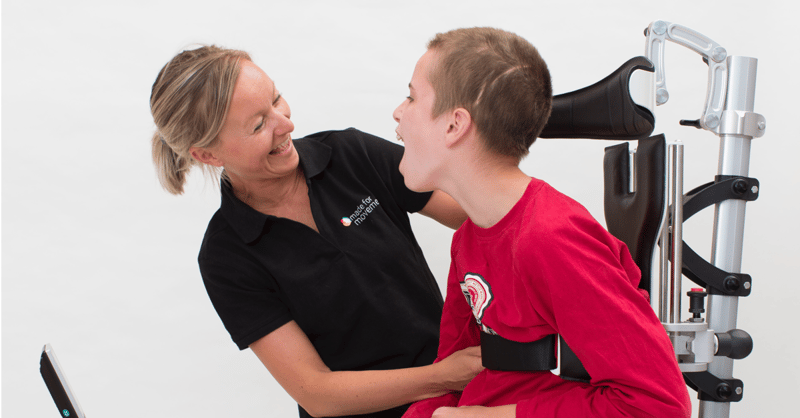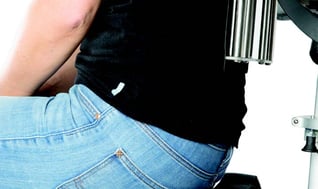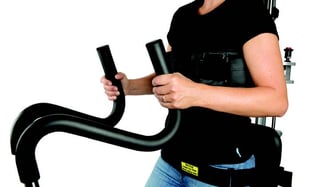How to transfer the user in and out of the Innowalk


Are you assisting a person using the Innowalk, but not quite sure how to get the user in and out of the assistive device? Here are some practical tips to make your work a little easier.

First, do a pre-check before use
It’s important that all activities conducted in an Innowalk is done safely. Before you start using the device, take some time to check the following:
- Tighten screws and parts if they are loose
- Verify the condition of the guide-string
- Test the seat and upright function
If you find any errors, broken parts, or hear any unusual sounds, please contact your Made for Movement representative. Please don’t allow the user into a defective assistive device – safety always comes first.
Related posts: Active Standing and the Advantages of Using the Innowalk
Transfer the user into Innowalk
 Before you start the process of assisting the user into the device, place the device in a sitting position and open all straps. We recommend using a personal lifter to transfer the user from a sitting position and into the Innowalk. This to reduce the load on you as an assistant, and for the comfort of the user. When positioned in the Innowalk, make sure that the user is sitting with the bottom well back on the seat.
Before you start the process of assisting the user into the device, place the device in a sitting position and open all straps. We recommend using a personal lifter to transfer the user from a sitting position and into the Innowalk. This to reduce the load on you as an assistant, and for the comfort of the user. When positioned in the Innowalk, make sure that the user is sitting with the bottom well back on the seat.
 Secure the chest strap, place the user’s legs in the calf-bow and attach the guide-string. It’s important to position the heel towards the back of the foot plate, and secure the user’s feet with straps as well. Remember, if you’re using an Innowalk Large, you have to attach the strap for the anti-overstretch on the calf-bow.
Secure the chest strap, place the user’s legs in the calf-bow and attach the guide-string. It’s important to position the heel towards the back of the foot plate, and secure the user’s feet with straps as well. Remember, if you’re using an Innowalk Large, you have to attach the strap for the anti-overstretch on the calf-bow.
When moving the user from sitting to standing position, hold on to the guide-string. As soon as the user is in a standing position, you can secure the hip-belt.
Attach any necessary accessories
 Depending on the user’s abilities, and what kind of movements you want to work on, you might have accessories available that you want to attach. Accessories include a table, anti-overstretch (support for the calf-bow), shoulder straps, and handles to enable arm motion.
Depending on the user’s abilities, and what kind of movements you want to work on, you might have accessories available that you want to attach. Accessories include a table, anti-overstretch (support for the calf-bow), shoulder straps, and handles to enable arm motion.
When you’re sure that the user is in a comfortable and optimal position, you can help him or her to start moving.
Adjust the speed according to needs.
How to transfer the user out of the device
When the user is done with the session, it's time to assist him or her out of Innowalk. Remove the table, shoulder straps, the strap for anti-overstretch (if it’s been used), and release the hip belt. Also, make sure to hold on to the guide-string to control the tension when moving from standing to sitting.
Release the straps over the user’s feet, as well as the guide-string and calf-bow. Lastly, release the chest support and transfer the user out of Innowalk. Again, we recommend using a personal lifter to assure safe transfer out of the device.
Remember that all people handling an Innowalk device should be trained by a Made for Movement representative. The representative can also train any new assistants or caretakers you may have with you, making sure the user gets a safe and good experience. If you need more information on how to use Innowalk, please get in touch with us.

Rikke Damkjær Moen brings many years of experience as clinical physiotherapist to the Made for Movement team. Her mission is to ensure that everybody, regardless of mobility problems, should be able to experience the joy and health benefits of physical activity. As our Medical Manager, Rikke is passionate about sharing knowledge so that individuals with special needs, families, and clinicians can discover the possibilities and solutions provided by Made for Movement.
A severe accident during a hockey game resulted in 35-year-old Tobias breaking his neck and becoming paralysed from the armpits down....
A disability entails the loss of, damage to, or deviation from bodily or psychological functions, in the form of mental, physical,...
The Neurological Interdisciplinary Treatment Centre NiB (Neurologisches Interdisziplinäres Behandlungszentrum) is an innovative...
Hear from us from time to time and learn new things
